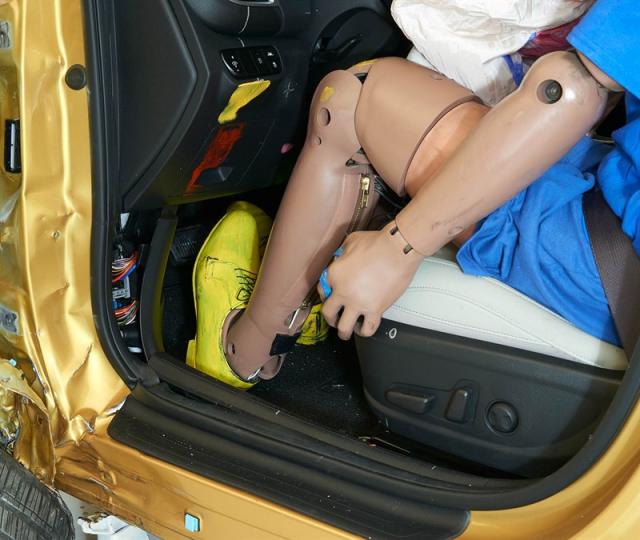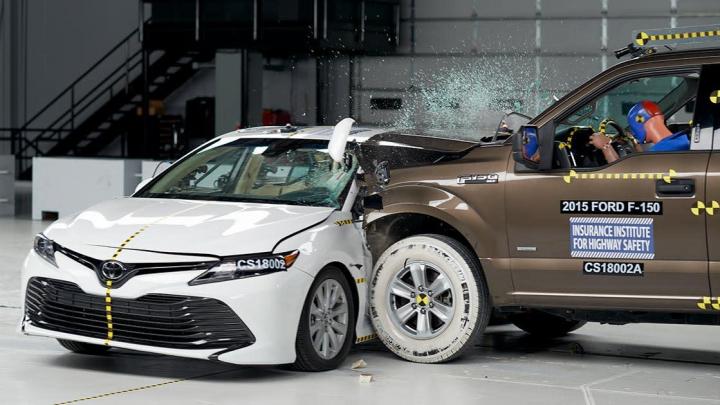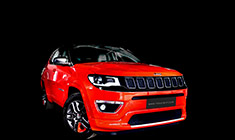News
Crash testing to get harder in the future, says IIHS
All trim levels of the vehicle need to receive acceptable or good ratings to be eligible for the award.
The Insurance Institute of Highway Safety (IIHS) has outlined the changes in criteria for 2024, while also announcing the changes it plans to make for 2025.
For vehicles trying to earn the Top Safety Pick (TSP) & Top Safety Pick+ (TSP+) awards, the tests will now be harder than the previous year. From 2024, a good rating in the side crash test with a heavier barrier is now necessary from the IIHS for a vehicle to get the awards. Previously, IIHS had separate evaluations for day & night pedestrian front crash prevention. This year, however, the tests will be combined into one and run both conditions - this prevents a vehicle from excelling in just one of the two tests and gain an award. The vehicle will have to score either an acceptable or good rating in both conditions to be eligible for the award.
For 2024, IIHS has also revised the scoring system for its small overlap front crash test. As per the updates, both driver and passenger-side evaluations are now clubbed as a single category, and the rating is the lower of the two results. Also, all trim levels of the vehicle need to receive acceptable or good ratings to be eligible for the award.
The organisation also went on to confirm that the crash tests are going to be even tougher in 2025. Joe Young, IIHS Spokesperson, said, "We will raise the bar again with more challenging criteria for 2025 Top Safety Picks, though the updates will be more modest." He further added, "The changes will relate to our updated moderate overlap crash test. A good or acceptable rating in that test is one requirement for the 2024 Top Safety Pick+ award. In 2025, the "plus" award will require a good rating, while the regular Top Safety Pick will require an acceptable rating."
Source: IIHS
- Tags:
- Indian
- IIHS
- International
- car safety
News
IIHS focus on rear-seat passenger safety tests
The improvement process can start with the inclusion of better seat belt parts, crash tensioners and force limiters.
Just last month, IIHS stated that rear-seat passengers have a 46% higher risk of injury than those sitting in the front seats. The reason for this was that while most of the cars concentrate on the safety of the front occupants, only a handful extend the same level of safety to the rear passengers.
Now, according to reports, IIHS has turned its attention towards improving rear-seat safety through a moderate overlap crash test. The test will see the addition of an adult-size dummy in the rear seat of cars to find out how they fare.
Taking the Honda Civic and Toyota Corolla sedans (both secured matching scores across all tests) as examples, IIHS found that rear-seat passengers experience "submarining". This is when the lap belt moves up onto the abdomen and increases the risk of internal injuries.
The testing agency believes that automakers can take the data from their tests and work on improving the safety of rear-seat occupants. The improvement process can start with the inclusion of better seat belt parts, crash tensioners and force limiters.
Source: CarScoops
- Tags:
- Indian
- IIHS
- International
News
American Kia Seltos secures a good score in IIHS crash tests
The Insurance Institute for Highway Safety (IIHS) has tested the 2021 model year Kia Seltos for the American market. The car scored high marks for crash worthiness and prevention but poor headlights prevented it from securing a safety award.
The Kia Seltos got good ratings in all six of the Institute's crash worthiness tests which include the driver and passenger-side small overlap front, moderate overlap front, side, roof strength and head restraint tests. In the US, the Seltos is offered with 2 crash avoidance systems - a camera system on the lower trims and a radar + camera combo on the SX Turbo trim. Both systems were able to avoid collisions at target speeds in vehicle-to-vehicle tests. The car slowed down substantially (to reduce severity of impact) or avoided the target in 3 different pedestrian scenarios.
One area in which the car got a "poor" rating were its headlamps. The Seltos is available with three headlight packages: base-level halogens, halogens with high-beam assist, and LEDs. All three were rated poor due to inadequate illumination on curves.
The India-spec Kia Seltos doesn't get crash prevention systems like the car sold in the US market.
Read the detailed report here.
- Tags:
- Indian
- Seltos
- IIHS
- crash test
News
Jeep Wrangler tips on its side during crash test
The Jeep Wrangler tipped over during the driver-side small overlap front crash test conducted by the Insurance Institute for Highway Safety (IIHS).
The test was conducted twice and the SUV rolled over in both instances. The car rolled onto its passenger side after hitting the barrier. The IIHS hence rated the safely of the car as marginal in the small overlap test.
While parameters like the driver's space and dummy's movement were normal in the test. Due to the rolling over, there are additional risks like occupant ejection from the vehicle. The Wrangler's door and roof are removable, which adds to the issue. Further, the SUV lacks curtain airbags which could help in rollover accidents.
In a test video submitted by FCA, the Wrangler did not tip over and company engineers questioned the IIHS' method of attaching the car to the propulsion system. However, the Wrangler tipped over in the second test as well, which used an FCA approved method.
- Tags:
- Indian
- IIHS
- Jeep Wrangler
- crash test
News
SUVs have a 28% higher chance of killing others in a crash
A new Insurance Institute for Highway Safety (IIHS) study shows that the driver of a car is 28% more likely to die if the car is hit by an SUV.
In 1989–1992, SUVs were 132% more likely to kill the driver of a car they collided with. During that period pick-up trucks were 159% more likely to kill other car drivers, whereas the figure now stands at 158%. The study examined deaths in accidents involving 1 to 4-year old passenger vehicles from 1989 to 2016.
The reasons for this incompatibility between a car and an SUV include factors like vehicle weight and ride height. Heavier cars will do more damage to lighter vehicles. SUVs also have a higher ride height, which means that the SUV's bumper is likely to hit the car's window, and not the stronger parts of the car like the doors. Crossovers, which have a lower ride height, are less dangerous than full-size SUVs.
Source: Jalopnik
- Tags:
- Indian
- Safety
- IIHS
- Road Safety
News
Japanese and Korean cars lead IIHS Safety Awards
25 out of the 30 cars in the ‘Top Safety Pick+’ and 22 out of 27 cars in the 'Top Safety Pick' award winners of the Insurance Institute for Highway Safety (IIHS) crash tests came from either Japanese or Korean carmakers.
IIHS has published a list of 57 cars across 2 categories for their Top Safety Pick choices. Out of the 57 models, 30 came under the Plus category, with the remaining 27 in the other category. The Plus category cars secured the highest ratings for passenger-side protection with good headlights while those in the next category got acceptable or higher in both passenger-side and headlight tests. All the 57 tested models received good rating in the other crashworthiness tests.
To be eligible for the Plus category, cars must receive a good rating for the passenger-side small overlap frontal test and must also have a good rating for the night-time headlight test. All 57 cars come with Autonomous Emergency Braking. The AEB and headlight criterion were added to lower the chances of a crash. Further, IIHS requires the passenger-side offset test as they have come across manufacturers strengthening only the driver side.
Last year, a rating of good or acceptable in the passenger-side offset test was enough to secure the top award. This has now been revised to good. Models with an acceptable or good rating will now be categorised in the ‘Top Safety Pick’ section.
Manufacturers like Hyundai, Kia, Genesis, Honda, Nissan, Toyota, Mazda, Audi, Mercedes-Benz and Chrysler were awarded. Brands like FCA’s Jeep, Dodge and Ram, GM’s Buick, Cadillac, Chevrolet and GMC, Ford, Lincoln and Tesla failed to qualify for both the awards. Volvo has not yet qualified due to missing passenger-side overlap crash test results.
For the full list, refer to this link.
- Tags:
- Indian
- International
- crash test
- IIHS
News
US-spec 2017 Hyundai Elantra scores maximum crash test rating
The US-Spec 2017 Hyundai Elantra has scored the Top Safety Pick Plus rating in the IIHS (Insurance Institute of Highway Safety) crash tests.
The IIHS crash test is divided in five categories: roof strength, head restraints and seats, moderate overlap frontal collision, side impact, and small overlap frontal collision. In comparison to the earlier model, the new Elantra showcased an improvement in the small overlap frontal collision category. While the earlier-gen Elantra suffered a maximum cabin intrusion of 9 inches, the new model suffered 2 inches of intrusion.
IIHS has specified that the top safety rating is being given to the models that have been produced after March 2016. This improved safety rating is mainly a result of Hyundai recently strengthening the junction between the door sill and hinge pillar.
The 2017 Elantra also comes with an optional Automatic Emergency Braking (AEB) system, which successfully avoided a collision at speeds of around 20 km/h on the institute's track test.
Source: AutoGuide















